
Playing to Win: How Strategy Really Works
by A.G. Lafley and Roger L. Martin. Harvard Business Review Press, 2013. 260 pages. US$27.00.Many chemical engineers (ChEs) are engaged in tactical implementation rather than strategic project development. However, understanding the firm's strategy can help improve project selection, team organization, and profitability at a company. ChEs, with our broad perspectives of people, processes, and technologies, are ideally suited to helping design business and innovation strategies.
Playing to Win, a new book by Procter and Gamble (P&G) CEO A.G. Lafley and co-author Roger Martin, lays out the key decisions a reader must make to implement a successful strategy. These questions are (pg. 15):
- What is your winning aspiration?
- Where to play?
- How to win?
- What are your core capabilities? and
- What management systems support the winning aspiration?
Each of the subsequent five chapters goes into detail on how a company's leadership team can address these questions.
Interestingly, the authors make a distinction between a passionate and specific set of choices (aspirations), and simply participating in a market. Mediocre performance without a desire to beat the competition is not a winning strategy.
The value of debate and dialogue
Two topics of particular interest to ChEs are in the later chapters of Playing to Win. In Chapter 6, "Manage What Matters," the authors stress the value of engaged debate and open dialogue. To enhance innovation at P&G, for example, project reviews were minimized while the conversations with senior management focused instead on strategic opportunities and technical advantages. Pre-determined agenda items can be circulated in advance of a meeting, eliminating thick (and boring) slide decks. Data dumps are replaced by two or three pages of competitor and customer analysis demonstrating market openings and product development opportunities.
A new approach to problems
While engineers and senior management can benefit from simplified strategic discussions, Chapter 7, "Think Through Strategy," introduces a new way to approach problems. In a traditional idea generation process, every possible concept is identified. Then, subject matter experts find all the ways that the idea won't work. In a "reverse-engineered strategy" discussion, the idea that might work is first identified. Team members stress positive attributes of what is required in order to make the concept successful in the marketplace. A final twist is that the biggest skeptic of the idea is challenged with designing the "failure test."
The theory is that if the biggest skeptic can be convinced of the merits of the idea, then everyone else will readily support the idea. Further, the "skeptics" will not have any incentive to sabotage the test with impossible criteria since the next project idea might be theirs, in which they will need the support of another team member designing a failure test.
Finally, Playing to Win wraps up with an excellent discussion of fundamental economic principles in Appendix B. For anyone who has grown rusty on supply and demand curves, cost leadership, or differentiated markets, this review is equally concise and easy to understand.
While many chemical engineers may not be directly involved in developing strategy for their firms, Playing to Win is still a great book to read. The text emphasizes customer and team member engagement backed by case study examples - both principles which benefit engineers in daily operations.


